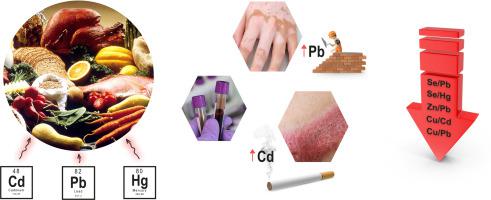Science of the Total Environment ( IF 8.2 ) Pub Date : 2020-12-03 , DOI: 10.1016/j.scitotenv.2020.143967 Marta Wacewicz-Muczyńska , Katarzyna Socha , Jolanta Soroczyńska , Marek Niczyporuk , Maria H. Borawska

|
Background
Psoriasis and vitiligo are common, autoimmune skin diseases, their etiology is still unclear. The relationship between environmental factors including diet and various skin diseases has been studied. The general mechanism of cadmium (Cd), lead (Pb) and mercury (Hg) toxicity is through the production of reactive oxygen species which are known to play a role in etiopathogenesis of skin disorders.
Objective
The aim of this study was to estimate the influence of dietary habits on the concentration of Cd, Pb and Hg in the peripheral blood samples of patients with psoriasis and vitiligo.
Methods
In this case-control study, sixty patients with psoriasis, fifty patients with vitiligo and fifty eight healthy people were examined. Blood levels of Cd, Pb and Hg were determined by atomic absorption spectrometry. Food-frequency questionnaires were implemented to collect the dietary data.
Results
Significant differences (p < 0.05) of Cd levels were found between women and men with psoriasis and women and men in the control group. The concentration of Pb was significantly higher among vitiligo patients (50.04 ± 26.54 μg/L) than in healthy controls (36.04 ± 27.35 μg/L). Significantly lower ratio of Se/Pb, Zn/Pb and Cu/Pb was found among psoriatic men. Significantly (p < 0.05) lower values of Se/Hg ratio were observed among vitiligo patients compared to controls.
Conclusions
The elevated levels of toxic elements could increase oxidative stress which may partly contribute to inflammation in the pathogenesis of psoriasis and vitiligo, which requires further research. Analysis of the influence of frequent consumption of food products on toxic metals concentration showed that the dietary habits have impact on the content of examined toxic metals in the blood of patients. The obtained results may be useful for composing the diet and could be helpful in prevention of psoriasis and vitiligo.
中文翻译:

银屑病和白癜风患者血液中的镉,铅和汞及其与饮食习惯的可能关系
背景
牛皮癣和白癜风是常见的自身免疫性皮肤病,其病因仍不清楚。已经研究了饮食等环境因素与各种皮肤疾病之间的关系。镉(Cd),铅(Pb)和汞(Hg)毒性的一般机理是通过产生活性氧,已知这些活性氧在皮肤疾病的发病机理中起作用。
目的
这项研究的目的是评估饮食习惯对银屑病和白癜风患者外周血中Cd,Pb和Hg的影响。
方法
在该病例对照研究中,检查了60名牛皮癣患者,50名白癜风患者和58名健康人。通过原子吸收光谱法测定血液中Cd,Pb和Hg的水平。实施了食物频率问卷调查以收集饮食数据。
结果
牛皮癣的男女患儿与对照组的男女患儿镉水平存在显着差异(p <0.05)。白癜风患者中Pb的浓度(50.04±26.54μg/ L)显着高于健康对照组(36.04±27.35μg/ L)。在银屑病男性中发现硒/铅,锌/铅和铜/铅的比率明显较低。 与对照组相比,白癜风患者的Se / Hg比值显着降低(p <0.05)。
结论
升高的有毒元素水平可能会增加氧化应激,这可能在牛皮癣和白癜风的发病机理中部分促成炎症,需要进一步研究。对经常食用食品对有毒金属浓度的影响进行分析后发现,饮食习惯对患者血液中被检有毒金属的含量有影响。所获得的结果可能有助于饮食结构,并有助于预防牛皮癣和白癜风。







































 京公网安备 11010802027423号
京公网安备 11010802027423号